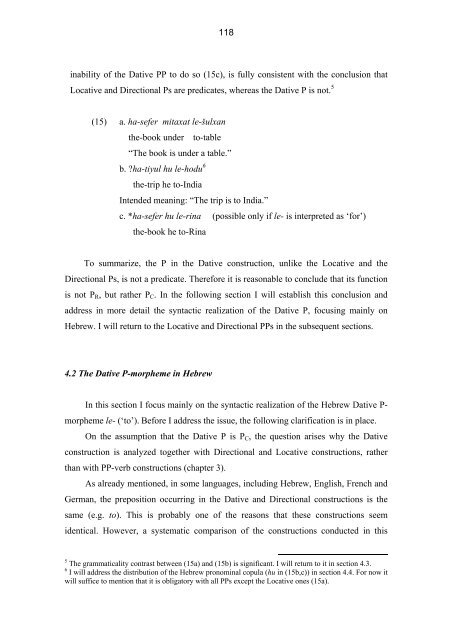The Category P Features, Projections, Interpretation
The Category P Features, Projections, Interpretation
The Category P Features, Projections, Interpretation
Create successful ePaper yourself
Turn your PDF publications into a flip-book with our unique Google optimized e-Paper software.
118<br />
inability of the Dative PP to do so (15c), is fully consistent with the conclusion that<br />
Locative and Directional Ps are predicates, whereas the Dative P is not. 5<br />
(15) a. ha-sefer mitaxat le-šulxan<br />
the-book under to-table<br />
“<strong>The</strong> book is under a table.”<br />
b. ?ha-tiyul hu le-hodu 6<br />
the-trip he to-India<br />
Intended meaning: “<strong>The</strong> trip is to India.”<br />
c. *ha-sefer hu le-rina (possible only if le- is interpreted as ‘for’)<br />
the-book he to-Rina<br />
To summarize, the P in the Dative construction, unlike the Locative and the<br />
Directional Ps, is not a predicate. <strong>The</strong>refore it is reasonable to conclude that its function<br />
is not P R , but rather P C . In the following section I will establish this conclusion and<br />
address in more detail the syntactic realization of the Dative P, focusing mainly on<br />
Hebrew. I will return to the Locative and Directional PPs in the subsequent sections.<br />
4.2 <strong>The</strong> Dative P-morpheme in Hebrew<br />
In this section I focus mainly on the syntactic realization of the Hebrew Dative P-<br />
morpheme le- (‘to’). Before I address the issue, the following clarification is in place.<br />
On the assumption that the Dative P is P C , the question arises why the Dative<br />
construction is analyzed together with Directional and Locative constructions, rather<br />
than with PP-verb constructions (chapter 3).<br />
As already mentioned, in some languages, including Hebrew, English, French and<br />
German, the preposition occurring in the Dative and Directional constructions is the<br />
same (e.g. to). This is probably one of the reasons that these constructions seem<br />
identical. However, a systematic comparison of the constructions conducted in this<br />
5 <strong>The</strong> grammaticality contrast between (15a) and (15b) is significant. I will return to it in section 4.3.<br />
6 I will address the distribution of the Hebrew pronominal copula (hu in (15b,c)) in section 4.4. For now it<br />
will suffice to mention that it is obligatory with all PPs except the Locative ones (15a).
















